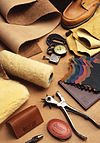Oiling (leather processing)
- Oiling (leather processing)
-
Oiling is a process whereby leather is hand coated (usually by brush or tampon) with either a raw (un-emulsified) oil or a combination of raw oil, blended with emulsified oils and a penetrating aid. Hand oils can include fragrant oils that help with the smell associated with the leather, e.g., Pine Oil. Hand oils commonly consist of sulfated vegetable oils, e.g. sulfated castor oil.
Oiling provides the leather with lubrication and allows it to flex repeatedly without cracking. Leather fibres that are dry and un-lubricated break very easily. Oiling does impart colour and an element of water resistance. Oiling would normally be performed on full grain aniline leathers. The most common type of leather oiled is vegetable tanned leather.
Wikimedia Foundation.
2010.
Look at other dictionaries:
Leather — For other uses, see Leather (disambiguation). Modern leather working tools Leather is a durable and flexible material created via the tanning of putrescible animal rawhide and skin, primarily cattlehide. It can be produced through different… … Wikipedia
Leather production processes — The leather manufacturing process is divided into 3 fundamental sub processes: preparatory stages, tanning and crusting. All true leathers will undergo these sub processes. A further sub process, surface coating can be added into the leather… … Wikipedia
Ostrich leather — is the result of tanning skins taken from African ostriches farmed for their feathers, skin and meat. The leather is distinctive for its pattern of bumps or vacant quill follicles, ranged across a smooth field in varying densities. It requires an … Wikipedia
Deliming — The deliming operation in leather processing is a drum/paddle or pit based operation where two main objectives are met:[1] Removal of alkali from the pelt and the consequent deswelling of the fibres. Lowering of the liquor pH to the values used… … Wikipedia
Business and Industry Review — ▪ 1999 Introduction Overview Annual Average Rates of Growth of Manufacturing Output, 1980 97, Table Pattern of Output, 1994 97, Table Index Numbers of Production, Employment, and Productivity in Manufacturing Industries, Table (For Annual… … Universalium

